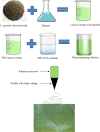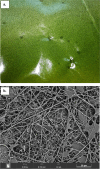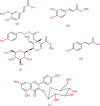Developing and Screening of a Bacteria-Fighting and Moisture-Controlling Coccinia grandis and Poly(vinyl alcohol) Electrospun Nanofibrous Mat
- PMID: 39035951
- PMCID: PMC11256095
- DOI: 10.1021/acsomega.4c03884
Developing and Screening of a Bacteria-Fighting and Moisture-Controlling Coccinia grandis and Poly(vinyl alcohol) Electrospun Nanofibrous Mat
Abstract
Nanofibers are extensively employed in the antimicrobial industry owing to their remarkable properties and diverse applications. Managing wounds poses a significant and enduring challenge for healthcare systems globally. This study aims to produce and evaluate electrospun nanofiber mats made from poly(vinyl alcohol) (PVA) and Coccinia grandis (C. grandis) leaf extract, highlighting the medicinal properties of this herbal product for potential biomedical applications (wound dressing). During the evaluations, a 60:40 ratio of PVA to leaf extract was found to be suitable, and the electrospinning process was utilized for production. Scanning electron microscopy was employed for morphological assessment, and an antibacterial assay was conducted against Staphylococcus aureus (S. aureus) and Escherichia coli (E. coli) to evaluate cell cytotoxicity. Additionally, Fourier-transform infrared spectroscopy (FTIR) and moisture management behavior (moisture management test) analyses were performed on the fabricated electrospun nanofibrous mat. The formation of small beads was confirmed, with the nanofibers having an average diameter of 295.07 ± 0.0032 nm and a porosity of approximately 76%, which is adequate for oxygen circulation and air ventilation, ensuring skin breathability. Gram-positive bacteria (S. aureus) exhibited a zone of inhibition (ZOI) of 14 mm, while Gram-negative bacteria (E. coli) showed a ZOI of 10 mm, attributed to the presence of a thick peptidoglycan cell wall in Gram-positive bacteria with no cell toxicity (100% cell viability). FTIR confirms the formation of weak van der Waals bonds and represents H-bonds between PVA polymer and C. grandis leaf extract. Furthermore, according to the MMT analysis, the electrospun nanofibrous mat demonstrates rapid absorption and slow drying properties. Therefore, the produced electrospun nanofibrous mat could prove beneficial for wound dressing purposes.
© 2024 The Authors. Published by American Chemical Society.
Conflict of interest statement
The authors declare no competing financial interest.
Figures











Similar articles
-
Fabrication and characterization of antimicrobial wound dressing nanofibrous materials by PVA-betel leaf extract.Heliyon. 2023 Jul 5;9(7):e17961. doi: 10.1016/j.heliyon.2023.e17961. eCollection 2023 Jul. Heliyon. 2023. PMID: 37483766 Free PMC article.
-
Wound dressing based on electrospun PVA/chitosan/starch nanofibrous mats: Fabrication, antibacterial and cytocompatibility evaluation and in vitro healing assay.Int J Biol Macromol. 2019 Feb 1;122:238-254. doi: 10.1016/j.ijbiomac.2018.10.115. Epub 2018 Oct 18. Int J Biol Macromol. 2019. PMID: 30342125
-
Poly(vinyl alcohol) /Alginate nanofibrous mats containing Malva Sylvestris extract: Synthesis, characterization, in vitro and in vivo assessments for burn wound applications.Int J Pharm. 2024 Apr 10;654:123928. doi: 10.1016/j.ijpharm.2024.123928. Epub 2024 Feb 23. Int J Pharm. 2024. PMID: 38401874
-
Antibacterial multicomponent electrospun nanofibrous mat through the synergistic effect of biopolymers.J Appl Biomater Funct Mater. 2022 Jan-Dec;20:22808000221136061. doi: 10.1177/22808000221136061. J Appl Biomater Funct Mater. 2022. PMID: 36346022
-
Synthesis, characterization, and antimicrobial properties of novel double layer nanocomposite electrospun fibers for wound dressing applications.Int J Nanomedicine. 2017 Mar 21;12:2205-2213. doi: 10.2147/IJN.S123417. eCollection 2017. Int J Nanomedicine. 2017. PMID: 28356737 Free PMC article.
References
-
- Tavakolizadeh M.; Pourjavadi A.; Ansari M.; Tebyanian H.; Seyyed Tabaei S. J.; Atarod M.; Rabiee N.; Bagherzadeh M.; Varma R. S. An environmentally friendly wound dressing based on a self-healing, extensible and compressible antibacterial hydrogel. Green Chem. 2021, 23 (3), 1312–1329. 10.1039/D0GC02719G. - DOI
-
- Altaf F.; Niazi M. B. K.; Jahan Z.; Ahmad T.; Akram M. A.; safdar A.; Butt M. S.; Noor T.; Sher F. Synthesis and Characterization of PVA/Starch Hydrogel Membranes Incorporating Essential Oils Aimed to be Used in Wound Dressing Applications. J. Polym. Environ. 2021, 29 (1), 156–174. 10.1007/s10924-020-01866-w. - DOI
-
- Mohamed A. A.; Alotaibi B. M. Essential oils of some medicinal plants and their biological activities: a mini review. J. Umm. Al-Qura Univ. Appl. Sci. 2023, 9 (1), 40–49. 10.1007/s43994-022-00018-1. - DOI
LinkOut - more resources
Full Text Sources
Miscellaneous
